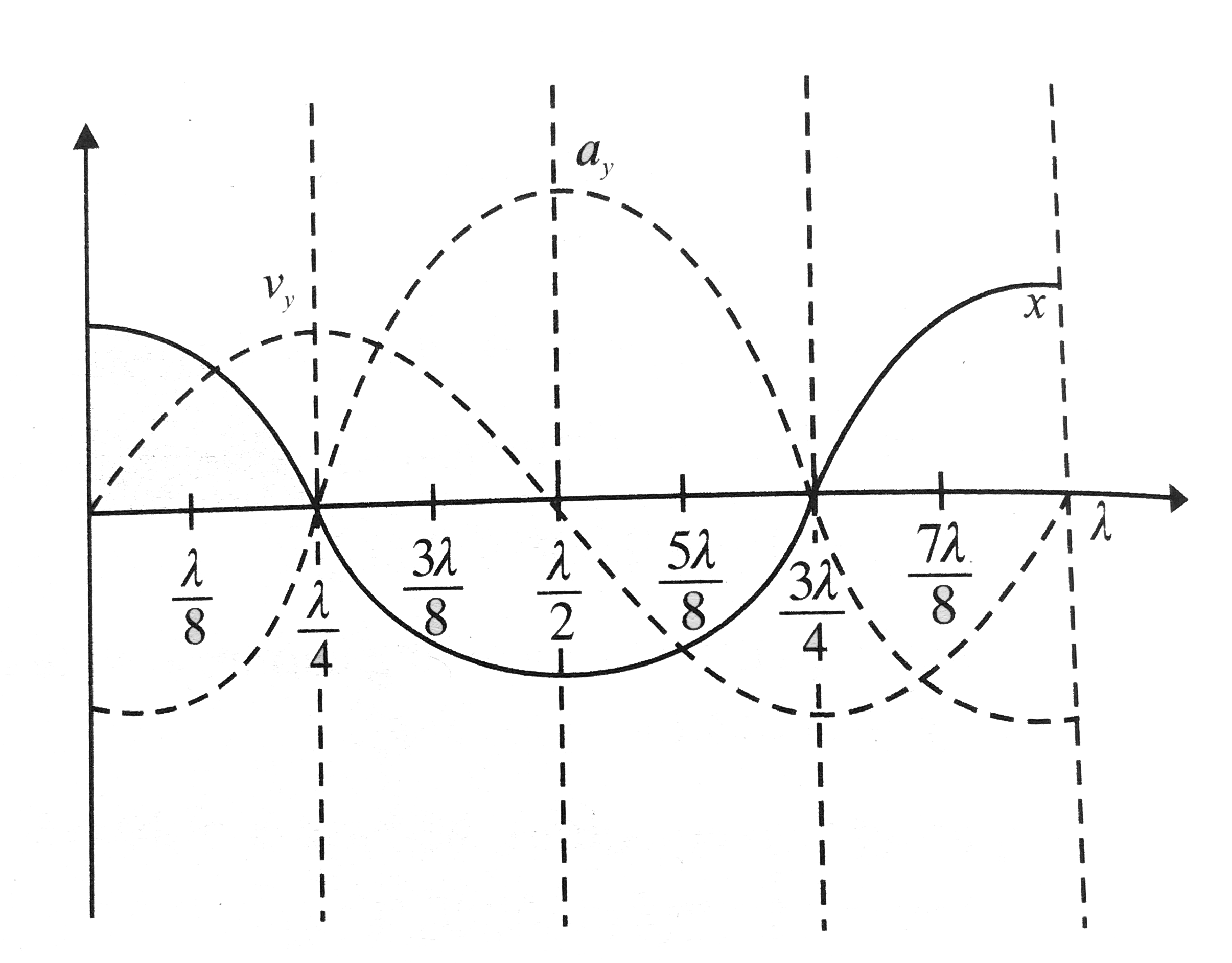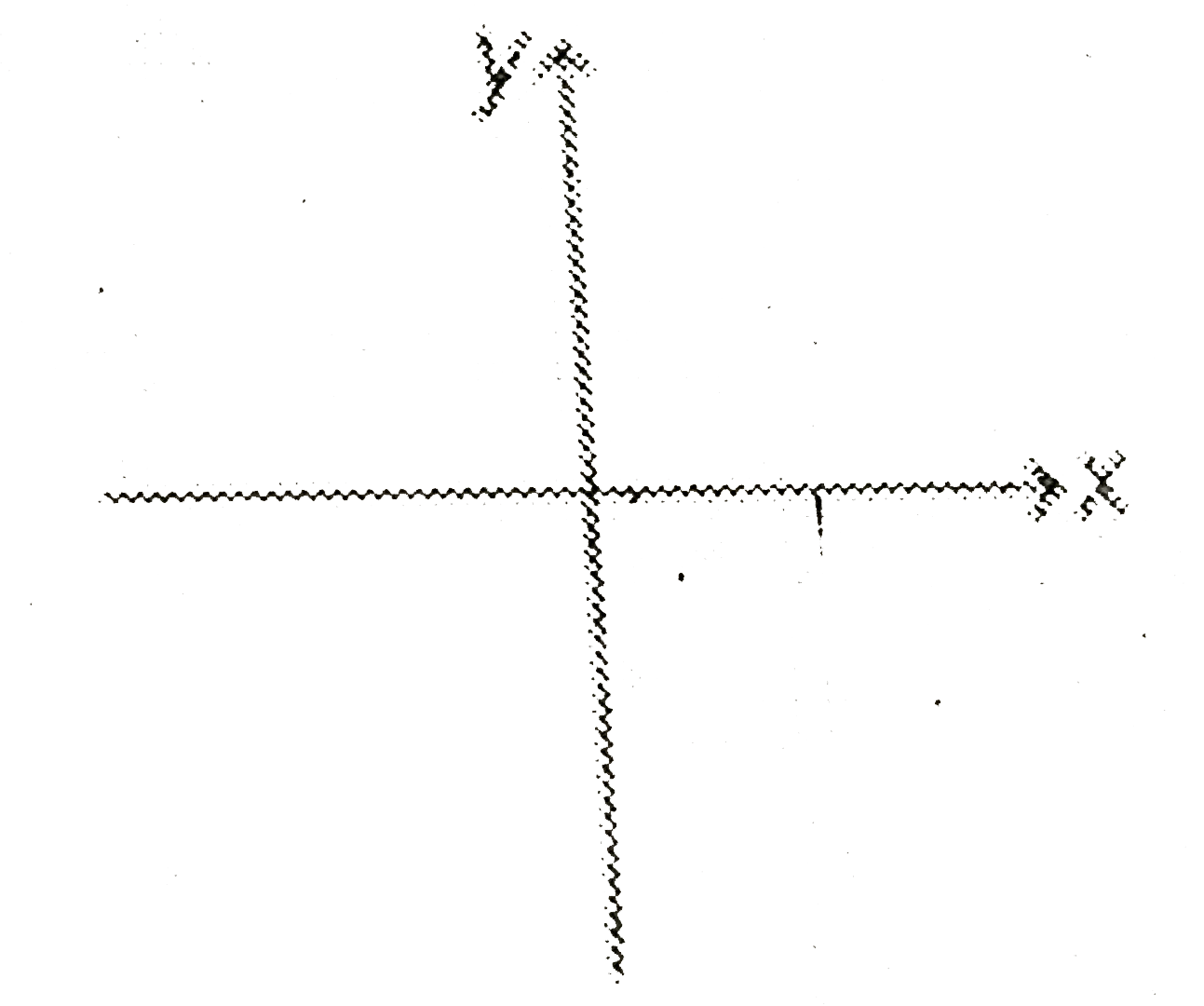A wave on a string is described by y(x,t)=Acos(kx−ωt). (a) Graph y,vy, and ay as function of x for time t=0. (b) consider the following points on the string: (i) x=0,(ii) x=pi//4k, (iii) x=pi//2k, (iv)x=3pi//4k, (v)x=pi//k, (vi)x=5pi//4k, (vii) x=3pi//2k, (viii) x=7pi//4k. For a particle at each of these points at t=0, describes in words whether the particle is moving and in what direction, and whether the particle is speeding up, slowing down, or instantaneously not acceleraring.
y=Acos(kx−ωt)
vy=dydt=Aωsin(kx−ωt)
ay=(dyydt=−ω2Acos(kx−ωt)=−ω2y
for t=0
y=Acos(kx)=Acos(2πλx) ltbr) vy=Aωsin(kx0=Aωsin(2πλx)
ay=−ω2Acos(kx)=−ω2Acos(2πλ)x)=−ω2y
(i) At x=0:y=A,vy=0, ay=−ω2A, the particle is at positive extreme position. It is at rest and accelerating downward at maximum acceleration.
(ii) At x=π4k=πλ4(2π)=λ8
y=Acos(2πλλ8)=A√2, vy=Aω√2, ay=−ω2A√2
the particle is above mean position, moving upward and slowing down. acceleration is in downward direction.
(iii) Atx=π2k=πλ2(2π)=λ4
herey=0, vyωA, ay=0
the particle is at mean position and moving upwards wire maximum velocity. acceleration of particle is zero.
(iv). At x=3π4k=3π8
here y=−A√2, vy=Aω√2, ay=ω2A√2
the particle is below mean position, having velocity acceleration both in upward direction. thus particle speeding up.
(v).At x=πk=λ2
here y=−A,vy=0,ay=ω2A
thepartic≤isat¬ativeextremepositionit∈stantaneouslyatrestandhav∈gae≤ration∈upwarddirection.<br>(vi)Atx=(5pi)/(4k)=(5pi)/(8),<br>herey=(-A)/sqrt(2),v_(y)=-(Aw)/sqrt(2),a_(y)=(w^(2)A)/sqrt(2)<br>thepartic≤isbelowmeanposition,mov∈gdownwardandae≤rationupward,thusslow∈gdown.<br>(vii)Atx=(3pi)/(2k)=(3lambda)/(4)<br>herey=0, v_(y)=-Aomega,a_(y)=0<br>Thepartic≤isatmeanpositionandmov∈gdownwardwithmaxiμmvelocity.ae≤rationofpartic≤iszer⊙<br>(viii).Atx=(7pi)/(4k)=(7lambda)/(8)<br>herey=(A)/sqrt(2),v_(y)=(Aomega)/sqrt(2), a_(y)=-(omega^(2)A)/sqrt(2)
the particle is above mean position, having velocity and acceleration both in downward direction. thus particle is speeding up.

Topper's Solved these Questions
- BOOK - CENGAGE PHYSICSCHAPTER - TRAVELLING WAVESEXERCISE - Subjective16videos
TRAVELLING WAVES
- BOOK - CENGAGE PHYSICSCHAPTER - TRAVELLING WAVESEXERCISE - Single Correct62videos
TRAVELLING WAVES
- BOOK - CENGAGE PHYSICSCHAPTER - TRAVELLING WAVESEXERCISE - Exercise 5.19videos
TRAVELLING WAVES
- BOOK - CENGAGE PHYSICSCHAPTER - TRANSMISSION OF HEATEXERCISE - Single correct9videos
TRANSMISSION OF HEAT
- BOOK - CENGAGE PHYSICSCHAPTER - VECTORSEXERCISE - Exercise Multiple Correct5videos
VECTORS
Similar Questions
Find the general solution of each of the following equations :
(i) sin3x=0
(ii) sin3x2=0
(iii) (x+π5)=0
(iv) cos2x=0
(v) cos5x2=0
(vi) cos(x+π10)=0
(vii) tan2x=0
(viii) tan(3x+π6)=0
(ix) tan(2x−π4)=0View SolutionFind the values of k so that the function f is continuous at the indicated point inf(x)={kcosxπ−2xifx≠π23ifx=π2 at x=π2
View Solution
Knowledge Check
- Question 1 - Select One
A xandy co-ordinates of a particle are x=Asin(ωt)andy=Asin(ωt+π/2). Then, the motion of the particle is
 Acircular anticlockwiseBcircular clockwiseCelliptical clockwiseDrectilinear
Acircular anticlockwiseBcircular clockwiseCelliptical clockwiseDrectilinear - Question 2 - Select One
The displacement of a particle is given by x=3sin(5πt)+4cos(5πt). The amplitude of particle is
A3B4C5D7 - Question 3 - Select One
If the function f(x)=[tan(π4+x)]1x for x≠0 is =K for x = 0
AeBe−1Ce2De−2
Find the value of k, if the functions are continuous at the points given against them :
f(x)=x−π4sinx−cosx,forx≠π4=k,forx=π4⎫⎪⎬⎪⎭atx=π4.View SolutionThe angle of rotation of axes so that √3x−y+1=0 transformed as y=k is (i)π6 (ii)π4 (iii)π3 (iv)π2
View SolutionThe solution(s) of the equation sin7x+cos2x=−2 is/are x=2kπ7+3π14, k∈I (b) x=nπ+π4 k∈I x=2nπ+π2, k∈I (d) none of these
View SolutionWhat is the value of k if the area bounded by the curve y=sinkx,y=0,x=π/k,x=π/(3k) is 3 sq units ?
View SolutionIf the area of the circle 4x2+4y2−8x+16y+k=0 is 9π square units, then the value of k is
View Solution

